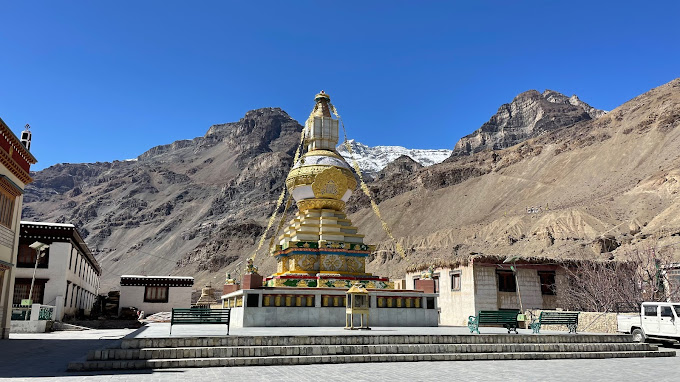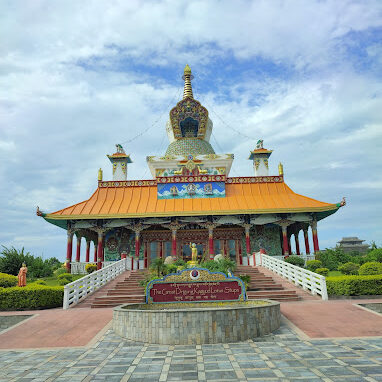Religion and spirituality are among the many pillars of building called life. Many religions in our world aid society in many ways. Buddhism is one of the oldest religions in the world. It is said that Buddhism originated in the Indian- Subcontinent however it has its roots in China, Japan and many Western countries. Gautam Budhha was an Indian prince who left worldly pleasures and left palace life in search of god. Today we are here to talk about 10 famous buddhist temples in the world, they are as follows:-
Also Read: Top 10 Tallest Buildings in the World in 2024 | Top Architectural Marvels
1. Tabo Monastery, Spiti Valley

It is the oldest monastery continuously operating in India and the Himalayas. It was developed by a Buddhist translator Rinchen Zangpo, who played an instrumental role in the translation of Buddhist text into the Tibetan language. He was patronized by the then monarch of Ladakh, who extended his kingdom to Mustang via trade routes. This monarchy also played a vital role in the revival of Indian Mahayana Buddhism in that area.
This monastery also has several artefacts and traditional paintings in its premises. The premise has many Fresco paintings depicting various tales from Buddhist stories ( Fresco is a traditional style of mural painting). This monastery also has a set of preserved manuscripts statues and paintings. They also have a special type of traditional Indian painting known as Thankas ( They are special scroll paintings).
This monastery also has been preserved by the Archeological Survey of India as one of the special treasures of India
2. Maya Devi Temple, Lumbini

It is located in the city of Lumbini Nepal. This temple was created when the ancient emperor Ashoka visited the city of Lumbini as a homage to Buddha as traditionally it was considered as hi birthplace where his mother Maya Devi gave birth to him while going to his father’s home at Kapilvastu . She died seven days after his birth then his stepmother Gautami raised him later she became the first nun of Buddhism. It is also considered to be a holy site in Buddhism as Buddha mentioned it in a sermon before he passed away. As this is believed to be the oldest temple with the efforts of the Nepalese Government since 2010 is in a UNESCO World Heritage site.
Suggested Read: Top 10 Most Prestigious Universities in the US: 2025 Rankings
3. Mahabodhi Temple , Bodhgaya

Mahabodhi temple situated in Bodhgaya Bihar shows several evidence of being as old as from Ashokan time and several sculptures of this temple also date back to the 2nd century CE or 3rd century CE which were removed from the temple complex for better preservation. Earlier the temple artefacts were made of bricks covered with stucco which fragile than the stone that’s why they didn’t survive.
The main temple complex has two large shikhara which influenced the later Hindu temple architecture. The Budhha is also supposed to plant a Mahabodhi tree there when he attained his nirvana. With the huge efforts of the Indian government, this temple also gets the recognition of a UNESCO World Heritage Site.
4. White Horse Temple, China

It is considered to be the first Buddhist temple of China, often termed as the “ cradle of Chinese Buddhism’’ and built-in 68 AD. It was built by Emperor Ming of the Eastern Han dynasty and renovated again during Qing Dynasties. the main temple has many statues of various bodhisattvas such as Maitreya etc. This temple is situated in the lap of mother nature and has an ample amount of scenic beauty suitable for tourism as it was built along the Lucoche River and south to the Manghan mountains.
5. Dambulla Cave Temple, Sri Lanka
It is located in Dambulla in the central part of the country near the capital city of Colombo. It is the largest and best-preserved cave complex in Sri Lanka which has more than 80 documented caves from which only five caves grab the central attention which belong to Buddhism. These caves and temples date back to around the 1st century BCE. Three of the five caves were known as Devraja Lena, Maharaja Lena and Maha Alut Vihara respectively. The statues situated in the caves give good impressions of Sinhalese art and sculpture.
6. Borobudur Temple, Indonesia
It was built in the 8th century AD or 9th century AD during the reign of the Sailendra Dynasty. This temple follows Javanese Buddhist Architecture with the Indonesian tradition of ancestor worship. It is located in Kedu Valley in the central part of Java. The main temple is a stupa which is built on three successive levels. The Temple was built from Andesite-like material. It was beautifully decorated with many relief panels and various Buddha statues. That’s why this temple is known for its collection of reliefs.
It is the world’s largest Buddhist temple and one of the most marvellous archaeological sites in Southeast Asia. It is also a part of the UNESCO World Heritage Site and one of the 7 wonders of UNESCO.
7. Tawang Monastery, India
It is the largest Buddhist monastery in India and the second largest monastery in the world located in Twang Chu Valley near the Chinese and Bhutanese border. It is also known by the name of Gaden Namgyal Lhatse which means “ the divine paradise of complete victory ’. This monastery was built and found by a person chosen by the 5th Dalai Lama. Earlier it faced stiff competition to knock out with Black hat sect of Buddhism which is why it was built like a fort and at a very strategic location to save the monks from the attacks. It was built with the support of local people due to the high terrain and many problems during the construction. It was also known for its conservation of ancient Buddhist text.
8. Na Hua Temple, Africa
It is the largest temple which is located in the continent of Africa located in Bronkhorstspruit, South Africa. It is a vast temple situated on 600 acres of land and established in 1967 by a Mahayanist Monk Venerable Master Hsing Yun. This temple also suffered a bomb blast in 2002 by a right-wing militancy group.
9. Todaiji Temple, Japan
It is located in the city of Nara in Japan it was among the Seven Great Temples located in Nara founded in 738 CE but it only opened in 752 CE when it was completely built. This temple was built on the lines of Chinese temple architecture such as that they want to imitate the whole Chinese style. It is also a world heritage site of UNESCO and one of Historic Monuments of Ancient Nara
10. Namdroling Nyingmapa Monastery
It was built by a person who was sent to exile from Ladakh around 1952 of Palyul lineage . It was built around 1963 and considered to be the second seat of Palyul Monastery wchic was one among the six important monasteries of Nyingmapa Mother Monastery which was situated in Tibet prior to its annexation.
Earlier when it was built it was just a mere structure of bamboo of just 80 square feet. It is built in the forest given to Tibetan exiles by the indian government
It is located in the Mysuru district in the state of Karnataka and it is the largest teaching centre of the Nyingma lineage of Tibetan Buddhism.








